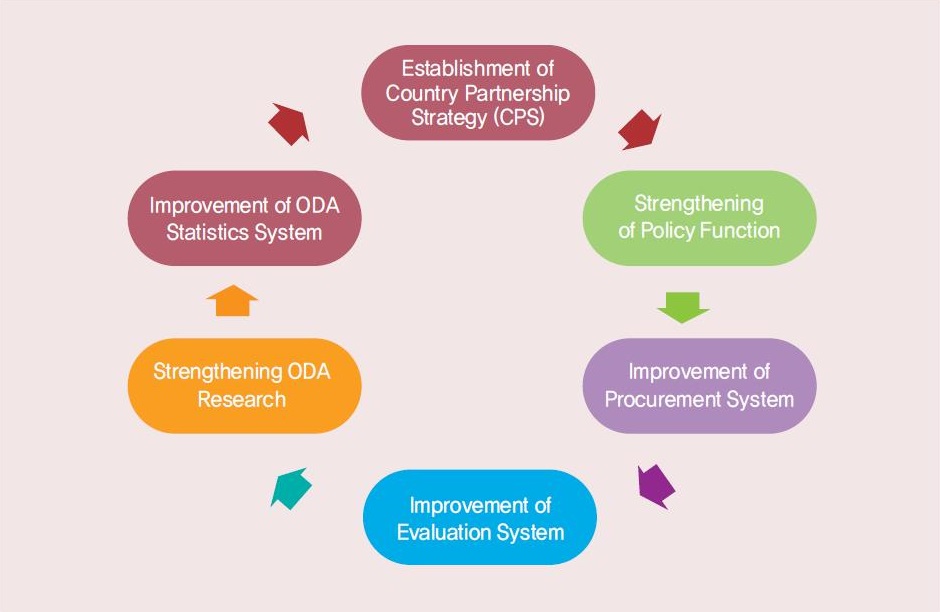all
Characteristics of KOICA assistance and delivery structure
1. Goal of KOICA Assistance
The fundamental spirit with which Korea approaches international development cooperation, laid out in the Basic Law on International Development Cooperation, is to pursue international peace and prosperity to encourage economic cooperation between partner countries in order to eradicate poverty, promote the rights of women and children, achieve gender equality, attain sustainable development, and implement humanitarian work.
KOICA’s untied development aid work adheres to the basic spirit, goal, and rules set out by the above-mentioned law. Accordingly, KOICA’s international development cooperation projects aim to help developing countries by reducing poverty, raising living standards, advancing the policy environment, and improving the circumstances for development. Through such projects, Korea’s cooperative relationship and exchange with developing countries will increase. On a greater scale, these projects will contribute to solving global problems that are related to international development cooperation. Furthermore, as a UN member, KOICA respects the various principles of the UN Charter as well as the independence, capacity, and development level of partner countries. KOICA endeavors to share Korea’s development experiences and improve the harmony and cooperation within the international community.
2. KOICA Assistance Strategy
KOICA’s first directive is to contribute to the international community’s efforts to eradicate poverty. In particular, KOICA contributes to the fulfillment of the Millennium Development Goals (MDGs) by the international community by 2015. Thus, KOICA takes into account regions where progress towards attaining the MDGs is slow and influential sectors as some of the major factors for consideration when giving assistance. Countries that receive special attention based on these criteria are the Least Developed Countries in South Asia and Sub-Saharan Africa. KOICA gives most of its aid in the health and medicine, education, food, and rural development sectors as these sectors have the most influence on progress towards achieving the MGDs. Second, KOICA places the highest importance on capacity building for developing countries to create a base for autonomous growth. In this way, development cooperation does not result in simple delivery of materials and personnel. The aim is help developing countries grasp the ‘opportunity’for self-motivated growth and induce them to take ‘responsibility’for their own development efforts.
Third, KOICA aims to contribute to world peace and prosperity by strengthening humanitarian aid in conflict and disasters areas as well as support peace building efforts. Currently, KOICA is gradually expanding humanitarian aid to conflict and disaster areas and is participating in the international communities’projects for strengthening governance in weak and conflict-ridden countries.
Fourth, KOICA aims to spread various values and norms in relation to the environment, gender equality, and human rights while establishing and implementing cooperative projects. KOICA plans to continuously pursue green growth for partner countries. It is involved with the‘ East Asian Climate Partnership’for building South East Asian countries’ capacity to respond to climate change. In addition, KOICA is attempting to bring issues, such as women and human rights, to the mainstream public’s attention. Awareness of this type of issue will improve human rights in partner countries and promote gender equality. Guidelines for gender equality and environmental preservation have been created and applied to all projects.
Fifth, KOICA aims to achieve more efficient development cooperation by continuously improving project implementation structures based on international development cooperation norms. For this purpose, KOICA has been employing norms on international aid effectiveness, including those addressed in the Paris Declaration, while implementing its projects. It has also been applying DAC recommendations in its work in projects dealing with untied international development aid, environmental preservation, poverty reduction, gender equality, stability in fragile states, and humanitarian assistance.
Finally, as a specialized agency for untied international development aid, KOICA profits from the know-how and specialized skills it has acquired over the past 20 years. For this purpose, KOICA is expanding and developing cooperative relationships with government organs, corporations, civil organizations, and other organizations that specialize in international development aid.
3. Assistance Delivery Structure
KOICA’s projects are implemented in the following cycle: Strategy Formation → Project Discovery, Development, and Screening → Project Implementation → Monitoring and Evaluation. This process is cyclical because the results from the monitoring and evaluation phase are applied during the strategy formation and project implementation. In this way feedback and the lessons learned lead to improvements in both policies and projects. KOICA was able to carry out this result-based management by steadily improving its project structure over the past 20 years.

[Figure 3-1] KOICA Project Implementation Structure
Source: Korea International Cooperation Agency. 2011. 20 years of KOICA 1991-2010, Translated by Institute for Development and Human Security, Ewha Womans University. Seoul.
